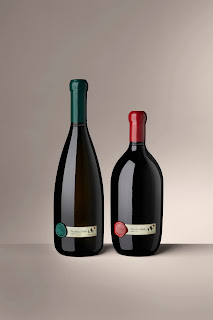I was honored with an invitation by Stevie Kim (Veronafiere) to go to the Metropolitan Club in NYC yesterday to taste two wines that were made to celebrate the 150th anniversary of the Unification of Italy. After a short presentation by Veronafiere CEO, Giovanni Mantovani, we were introduced to the unique wines.
They were created thanks to the blending of 20 white wines and 20 red wines that came from the same number of autochthonous grapes, 20 white varieties and 20 red varieties, from each Italian region and chosen by the region’s Agricultural Supervisor.
The wines were then evaluated by a commission of enologists who were chosen by the Associazione Enologi Enotecnici Italiani (Italian Enologist and Enotechnicians Association). They proceeded to select the wines to be used and the percentages of each that would be added to the final blends.
The white wine is a representative selection of wines made from autochthonous varieties harvested in 2009. None of the wines were aged in oak.
13.5% alcohol. Straw yellow, not very aromatic, with good acidity and a citric character; the wine was fruity, fresh and said loud and clear: "Hey, I'm Italian!"
The red wine comes from wines that were produced during the years 2005 to 2009, some of which were aged in wood.
14% alcohol. Brilliant ruby red, a complex nose with lots of fruit, spices and a hint of wood. The same sensations on the palate with a very good integration between the fruit and the oak. The wine has a good tannic structure and needs more time in the bottle to show his full potential.
I'll publish the list with the grape varieties (and from each region) in the next few days, giving to you the opportunity to try to guess what they are...
And I hope I'll see you at Vinitaly next week. Let's enjoy together a glass (or two) of a great Italian wine?
Cheers,
LA
They were created thanks to the blending of 20 white wines and 20 red wines that came from the same number of autochthonous grapes, 20 white varieties and 20 red varieties, from each Italian region and chosen by the region’s Agricultural Supervisor.
The wines were then evaluated by a commission of enologists who were chosen by the Associazione Enologi Enotecnici Italiani (Italian Enologist and Enotechnicians Association). They proceeded to select the wines to be used and the percentages of each that would be added to the final blends.
The white wine is a representative selection of wines made from autochthonous varieties harvested in 2009. None of the wines were aged in oak.
13.5% alcohol. Straw yellow, not very aromatic, with good acidity and a citric character; the wine was fruity, fresh and said loud and clear: "Hey, I'm Italian!"
The red wine comes from wines that were produced during the years 2005 to 2009, some of which were aged in wood.
14% alcohol. Brilliant ruby red, a complex nose with lots of fruit, spices and a hint of wood. The same sensations on the palate with a very good integration between the fruit and the oak. The wine has a good tannic structure and needs more time in the bottle to show his full potential.
I'll publish the list with the grape varieties (and from each region) in the next few days, giving to you the opportunity to try to guess what they are...
And I hope I'll see you at Vinitaly next week. Let's enjoy together a glass (or two) of a great Italian wine?
Cheers,
LA
www.thewinehub.com
One of the pillars of TheWineHub is Wine Tourism. Whether you are a wine maker, or a wine drinker, we all enjoy having discoveries... TheWineHub exists to help you with that.
One of the pillars of TheWineHub is Wine Tourism. Whether you are a wine maker, or a wine drinker, we all enjoy having discoveries... TheWineHub exists to help you with that.






5 comments:
The 20 grape varieties and their correspondent regions for the "Una Bianco":
1) Trebbiano - Abbruzzo
I can play this game.
How about Chianti Classico for a 2)
guess. Joel Dee/Berlino
These two wines are a small joke on the country — there can be no DOC or IGT designation. Just red and white. Plonk.
And probably a big price to pay all the people who worked on it.
Each of the regions should have made their own 2 wines to help keep the DOC IGT DOCG laws working.
Bob,
I believe these wines are not going to be available for sale...
Only a very limited number of bottles was produced and they will be given as gifts.
And by the way, I tasted the wines and they are not plonk. They are very good if you ask my humble opinion.
Have you tasted them or are you just judging them to be bad because they cannot be DOC?
Thanks.
2) Basilicata: Greco
3) Calabria: Greco bianco
4) Campania: Fiano
5) Emilia Romagna: Pignoletto
6) Friuli Venezia Giulia: Friulano
7) Lazio: Malvasia
8) Liguria: Vermentino
9) Lombardia: Trebbiano di Lugana
10) Marche: Verdicchio
11) Molise: Falanghina
12) Piedmont: Cortese
13) Puglia: Fiano
14) Sardegna: Vermentino
15) Sicilia: Grillo
16) Toscana: Vernaccia di San Gimignano
17) Trentino: Weissburgunder
18) Umbria: Grechetto
19) Valle d'Aosta: Prie blanc
20) Veento: Garganega
Post a Comment